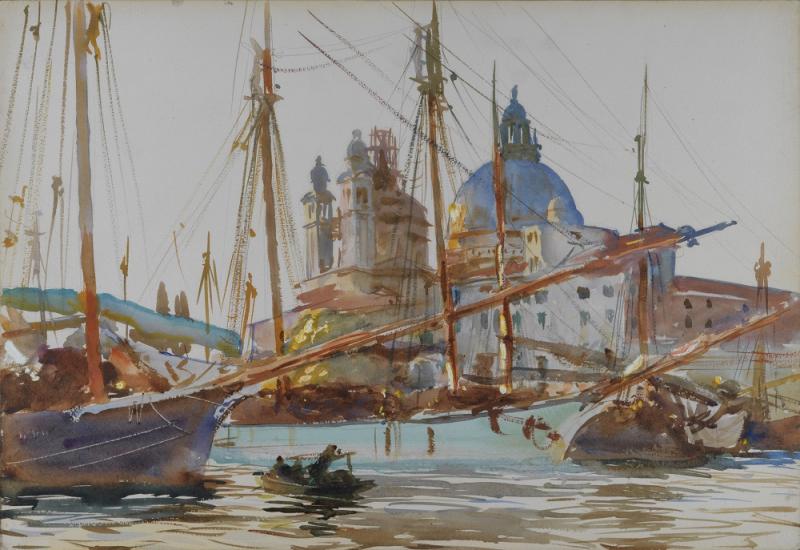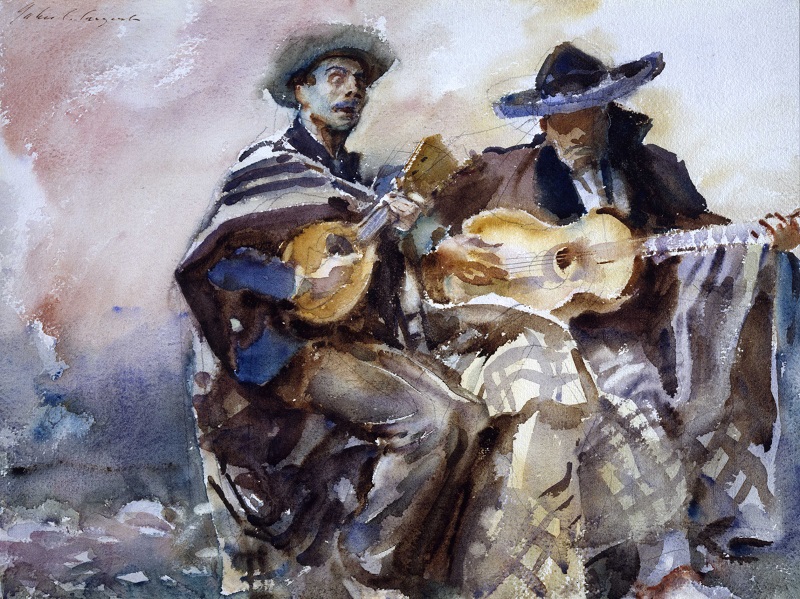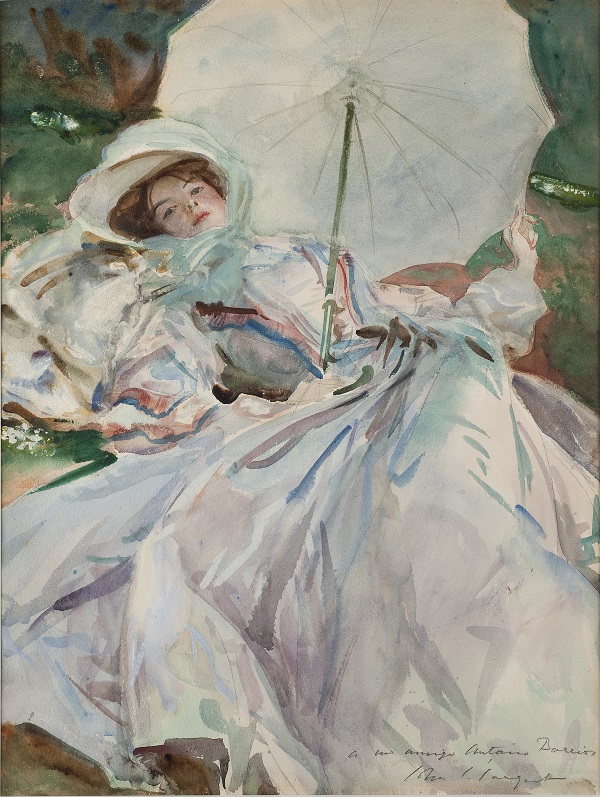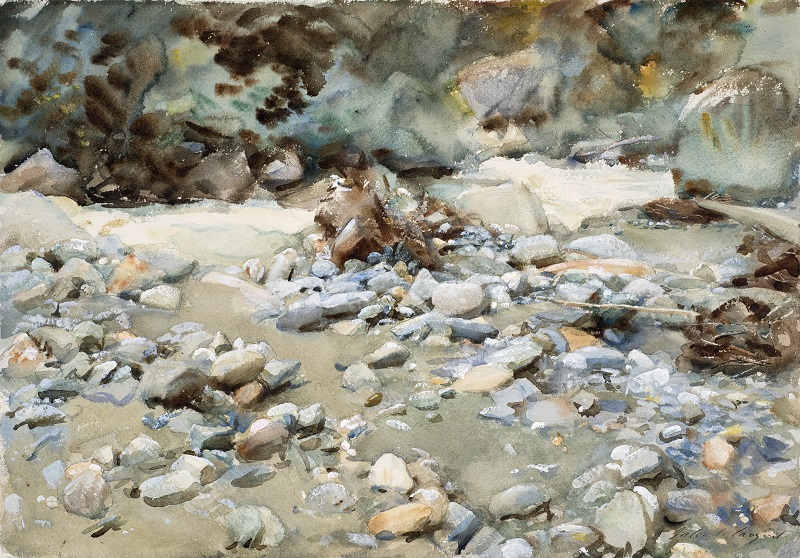Sargent, Dulwich Picture Gallery review - wonders in watercolour | reviews, news & interviews
Sargent, Dulwich Picture Gallery review - wonders in watercolour
Sargent, Dulwich Picture Gallery review - wonders in watercolour
The great portraitist lets his hair down

This sparkling display of some four score watercolours from the first decade of the last century throw an unfamiliar light on the artistry of John Singer Sargent (1856-1925), the last great swagger portrait painter in the western tradition.
As for many artists over the centuries, Venice figures large. It is a city that Sargent knew well, visiting it over some four decades. Early in the 1880s he knew its leading residents, notably a circle round the Palazzo Barbaro made up of grand East Coast American expats and the British and Italian upper classes. Paintings from the 1880s, including some of young Venetian women of the working classes, stringing beads and gossiping to amuse themselves foreshadow a growing informality. For what is striking in this selection from years later in his career is a loosening of inhibition. His lucrative portraiture practice could mean that he was captive to social expectations, but here he was in command of both his schedule and his choices, and in his own phrase, taking time off from the endless round of painting “mug shots”. Success can be imprisoning. (Pictured below: Blind Musicians, 1912)
 In many of the paintings here, the vantage point is a surprise, with many of the views of Venice taken as if from a gondola, looking over and up to buildings and boats over the shimmering water of the canals (main picture). They give the sense of a casual gaze, as though we were ourselves visitors wandering through the city, drawn by both the magnificent and the picturesque. Alongside those are exquisite close-ups of Alpine streams, studies of his sister and friends on Alpine painting holidays, and classic male nudes (no profound sexual attachment of Sargent to any gender has yet been proven, although much has been suggested: I know of no female nudes).
In many of the paintings here, the vantage point is a surprise, with many of the views of Venice taken as if from a gondola, looking over and up to buildings and boats over the shimmering water of the canals (main picture). They give the sense of a casual gaze, as though we were ourselves visitors wandering through the city, drawn by both the magnificent and the picturesque. Alongside those are exquisite close-ups of Alpine streams, studies of his sister and friends on Alpine painting holidays, and classic male nudes (no profound sexual attachment of Sargent to any gender has yet been proven, although much has been suggested: I know of no female nudes).
The compositions are also a surprise: Sargent was interested in photography, so there is an implication that the slanted, oblique views, off-centre compositions, snapshots in all but name, might have been influenced by advances in the medium. There is an affectionate tenderness, a sense of exploration and delight in the unexpected that pervades these images, regardless of subject matter.
 There is a marvellously sly mix of brush strokes – slashes, curves, rivulets, squiggles and doodles, which magically resolve into a fully realised scene. A clever exploitation of empty space is as integral and meaningful to his compositions as descriptive paint, with gouache used as tellingly as flicks of watercolour. His imaginative use of colour means that slashes of emerald and reds, purples and browns, oranges and pale blues, can convince one of the reality of stones in a stream, Venetian gondolas, Renaissance façades, wooded parks, the Mediterranean, a beach, a flowing white dress (pictured right: The Lady with the Umbrella, 1911).
There is a marvellously sly mix of brush strokes – slashes, curves, rivulets, squiggles and doodles, which magically resolve into a fully realised scene. A clever exploitation of empty space is as integral and meaningful to his compositions as descriptive paint, with gouache used as tellingly as flicks of watercolour. His imaginative use of colour means that slashes of emerald and reds, purples and browns, oranges and pale blues, can convince one of the reality of stones in a stream, Venetian gondolas, Renaissance façades, wooded parks, the Mediterranean, a beach, a flowing white dress (pictured right: The Lady with the Umbrella, 1911).
It is clear too that what he excels at is the close-up, often portraying an eye-catching detail rather than a vista; in fact, the Alpine vistas are curiously flat, almost like stage sets (pictured below: Bed of a Torrent, c.1904). What he achieved in these wonders in watercolour was a sense of changing light revealing the shapes of nature, architecture and the intricacies of the human form. No painstaking detail: instead a patchwork of colour which, close up, is staggeringly abstract, providing a convincing illusion of observed reality.
Sargent was truly cosmopolitan, described thus: an American born in Italy (to ex-pat parents in Florence), educated in France, who looked like a German, spoke like an Englishman, and painted like a Spaniard. He did not even visit his ancestral country until 1876, the centenary of American independence. In some respects he led a charmed life. He was multi-talented, a gifted linguist, a superb musician, and with a superb artistic technique that sometimes convinced critics that it was all too easy. He painted the rich, the famous, the glitterati, the literati, everyone at the top of the heap, from American presidents and Rockefeller family members to the grand expats, aristocrats and intellectuals of France and Britain. To be painted by Sargent, one wit said, was to ascend prematurely into heaven, whilst Sargent himself, all too aware of the pitfalls of portraiture, declared that a portrait was a painting where something was not quite right about the mouth.
 Developments in “modern” art, social changes, and what seemed to be his breathtaking virtuosity made for a context that easily dismissed Sargent’s manifold achievements as mindless. Rather like Whistler, Sargent dropped out of fashion and critical scrutiny until the 1980s. Recent decades have seen a substantial series of biographies, catalogues and exhibitions that have suggested a stature far beyond that of a fashionable portrait painter.
Developments in “modern” art, social changes, and what seemed to be his breathtaking virtuosity made for a context that easily dismissed Sargent’s manifold achievements as mindless. Rather like Whistler, Sargent dropped out of fashion and critical scrutiny until the 1980s. Recent decades have seen a substantial series of biographies, catalogues and exhibitions that have suggested a stature far beyond that of a fashionable portrait painter.
In this charming compilation, it is so evident he painted for pure pleasure, with a highly original sense of colour and a captivating way with composition. The result is a seductive glimpse into the architecture of his chosen cities, of scenes in Italy, France, Scotland, and the beauties of European landscape. Even the ruins of war have a poignant appeal.
- Sargent: The Watercolours at Dulwich Picture Gallery to 8 October
- Read more visual arts reviews on theartsdesk
rating
Share this article
Subscribe to theartsdesk.com
Thank you for continuing to read our work on theartsdesk.com. For unlimited access to every article in its entirety, including our archive of more than 15,000 pieces, we're asking for £5 per month or £40 per year. We feel it's a very good deal, and hope you do too.
To take a subscription now simply click here.
And if you're looking for that extra gift for a friend or family member, why not treat them to a theartsdesk.com gift subscription?
more Visual arts
 Brancusi, Pompidou Centre, Paris review - a sculptor's spiritual quest for form and essence
The Paris landmark signs off with a historic survey
Brancusi, Pompidou Centre, Paris review - a sculptor's spiritual quest for form and essence
The Paris landmark signs off with a historic survey
 Expressionists: Kandinsky, Münter and the Blue Rider, Tate Modern review - a missed opportunity
Wonderful paintings, but only half the story
Expressionists: Kandinsky, Münter and the Blue Rider, Tate Modern review - a missed opportunity
Wonderful paintings, but only half the story
 Eye to Eye: Homage to Ernst Scheidegger, MASI Lugano review - era-defining artist portraits
One of Switzerland's greatest photographers celebrated with a major retrospective
Eye to Eye: Homage to Ernst Scheidegger, MASI Lugano review - era-defining artist portraits
One of Switzerland's greatest photographers celebrated with a major retrospective
 Stephen review - a breathtakingly good first feature by a multi-media artist
Melanie Manchot's debut is strikingly intelligent and compelling
Stephen review - a breathtakingly good first feature by a multi-media artist
Melanie Manchot's debut is strikingly intelligent and compelling
 Fantastic Machine review - photography's story from one camera to 45 billion
Love it or hate it, the photographic image has ensnared us all
Fantastic Machine review - photography's story from one camera to 45 billion
Love it or hate it, the photographic image has ensnared us all
 Yinka Shonibare: Suspended States, Serpentine Gallery review - pure delight
Weighty subject matter treated with the lightest of touch
Yinka Shonibare: Suspended States, Serpentine Gallery review - pure delight
Weighty subject matter treated with the lightest of touch
 Jane Harris: Ellipse, Frac Nouvelle-Aquitaine MÉCA, Bordeaux review - ovals to the fore
Persistence and conviction in the works of the late English painter
Jane Harris: Ellipse, Frac Nouvelle-Aquitaine MÉCA, Bordeaux review - ovals to the fore
Persistence and conviction in the works of the late English painter
 Sargent and Fashion, Tate Britain review - portraiture as a performance
London’s elite posing dressed up to the nines
Sargent and Fashion, Tate Britain review - portraiture as a performance
London’s elite posing dressed up to the nines
 Zineb Sedira: Dreams Have No Titles, Whitechapel Gallery review - a disorientating mix of fact and fiction
An exhibition that begs the question 'What and where is home?'
Zineb Sedira: Dreams Have No Titles, Whitechapel Gallery review - a disorientating mix of fact and fiction
An exhibition that begs the question 'What and where is home?'
 Yoko Ono: Music of the Mind, Tate Modern review - a fitting celebration of the early years
Acknowledgement as a major avant garde artist comes at 90
Yoko Ono: Music of the Mind, Tate Modern review - a fitting celebration of the early years
Acknowledgement as a major avant garde artist comes at 90
 Unravel: The Power and Politics of Textiles in Art, Barbican review - the fabric of dissent
An ambitious exploration of a neglected medium
Unravel: The Power and Politics of Textiles in Art, Barbican review - the fabric of dissent
An ambitious exploration of a neglected medium
 When Forms Come Alive, Hayward Gallery review - how to reduce good art to family fun
Seriously good sculptures presented as little more than playthings or jokes
When Forms Come Alive, Hayward Gallery review - how to reduce good art to family fun
Seriously good sculptures presented as little more than playthings or jokes

Add comment